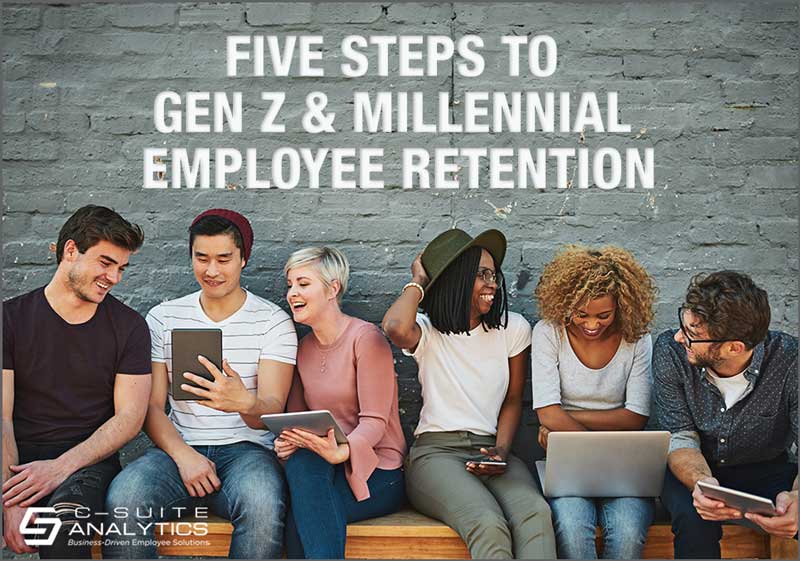At SHRM Talent Conference 2024 I asked the room this question: Who here has ever heard of one manager getting fired for a low employee engagement survey score? Please raise your hand if you can think of even just one. The only sound was the 400-plus attendees turning in their seats to see if anyone raised their hands. There were no hands up.
Five Steps to Gen Z & Millennial Employee Retention

Step #1: Lock in on these key employee retention words: Flexibility, mobility, entrepreneurial freedom
Make them pop up on your computer screen first thing each morning. Develop an acronym for them so you can say them more quickly. I couldn’t think of one but maybe you can. Let’s settle on MEFF for today.
Microsoft says these are the at-work values young workers hold onto most dearly. Their study covered 31,000 workers across 31 countries along with analysis of “trillions of productivity signals in Microsoft 365 and labor trends on LinkedIn”[i]. Any study that references trillions makes me buy in. Microsoft also says 53% of your Gen Z and millennials will consider leaving this year.
These are no longer “young kids”. The two generational groups together comprise more than half of our workforce. And their percentage increases every day. One employee quote from the Microsoft study nailed how the pandemic changed the ways our workforce reconsidered their jobs:
“Covid has not been all doom and gloom for me. It forced me to dig deep and reevaluate what is important.”
Step #2: Consider Your Company’s Opportunities to Provide MEFF for Employee Retention
Words like “boundaries” help our minds build fences whereas “opportunities” knocks those fences down. Way back before the pandemic made working from home a hip thing, that’s dope for our young readers, I read a study that rank-ordered jobs that could be done remotely. Technology workers sat atop the list with teachers at the bottom.
Let’s split your jobs into two categories with Group A being those jobs where MEFF is imaginable like financial analysts, and Group B where MEFF seems impossible like nurses, security guards, manufacturing workers, bartenders…the jobs where employees must be in the same location every day.
If your company is comprised mainly of Group A jobs, the so-called knowledge workers, you have an easier path. Your main challenges are to wake up your executive team with articles like this one so they open their minds to MEFF, and then update policies so employees can contribute on their own schedules and from wherever. The trickier part will be how to assign work and measure outcomes that verify your MEFF workers are achieving at high or acceptable levels.
To be clear, I’m not saying climbing the Group A mountaintop is easy, just that it is easier than solving MEFF for Group B employers since MEFF jobs are the “gotta be there” jobs. Let’s turn our focus to those companies who have Group B jobs next.
Step #3: Rethink How MEFF Employee Retention Meshes with Work Schedules
Re-reading our MEFF words tells us mobility is out for our Group B jobs so flexibility must be in. Here are five ways to increase schedule flexibility:
Way 1: Remove forced-flexibility first by locking in scheduled work days and hours so employees can plan their non-work hours around families, schools, and other life events. Forced shift rotations must end.
Way 2: Pay employees to accommodate their peers by changing shifts for a day. We all know stories of workers asking others to switch shifts so they can meet with their kids’ teachers. Commit to paying any co-worker who says “yes” an additional three dollars an hour for the shift they take. That’s buying increased flexibility for about $25 per schedule change which is peanuts compared to the cost of losing high-performing employees during The Great Resignation.
Way 3: Honor those employees who volunteer to change schedules most frequently. Post how often they say “yes” publicly so all know their schedule-changing heroes. Hold quarterly hero drawings for gift cards or weekend getaways where each shift change equates to one slip of paper in the bowl. Give shift-changers extra credit for their unique contributions because you must retain them.
Way 4: Base all permanent shift changes on performance vs length of service, otherwise you are telling sharp new hires they will be long stuck on night shift. Ask a team of top-performing incumbents to identify the precise performance metric you will use, even if you have to invent one.
Way 5: Significantly increase shift differentials. Per-hour pay means more to those seeking work than those already onboard. Signify to potential new hires that you will make it worthwhile for them to adjust their lives to meet your business needs.
Step #4: Triple Your Percent of Jobs Filled by Employee Referrals to Make It Your Best Recruiting Tactic
As I’ve written here before, employee referrals are directly related to the cost of turnover. Pay an eye-grabbing amount and pay it all upfront because most hourly workers live paycheck to paycheck. Hold new-hire trainers accountable to referral goals because new hires know the best workers from the job they just left. Double the payout for life for anyone who refers five workers you hire. Hold referral open houses by appointment only and ask your employees one-by-one who they will bring.
Don’t be cheap. Invite your CFO to use our turnover cost calculator so she can balance the cost of retaining versus the cost of losing talent. You can find it here at https://c-suiteanalytics.com
Step #5: Train Your Leaders to Conduct Stay Interviews for Employee Retention
Steps one through four assume all employees want the same things but in reality they do not. Retention is now an individualized game and your best retention solution continues to be each employee’s direct supervisor. This is the person whose name your employees say over dinner, surrounded by good adjectives or bad. Let those supervisors learn how best to retain each member of their team and then hold them accountable for doing so.
Not all MEFF-related issues can be solved by policies alone. Supervisors conducting Stay Interviews are your best opportunity to identify the entrepreneurial freedom in MEFF. Train supervisors to listen…truly listen…to what each employee needs to thrive and to stay. Together with their manager they can find one-off assignments, task force participations, and even readings and webcasts for employees to grow new skills.
Employee Retention Is More Important Than Ever During The Great Resignation
Schedule a conversation with me at DFinnegan@C-SuiteAnalytics.com to discuss your employee retention roadblocks and I’ll share ideas for how you can move forward and what is working for other companies to cut turnover by 20% and more, even during The Great Resignation that may benefit you.
[i] https://www.microsoft.com/en-us/worklab/work-trend-index/great-expectations-making-hybrid-work-work



